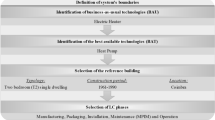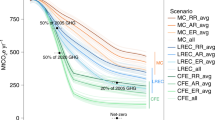Abstract
Purpose
Increases in residential insulation can reduce energy consumption and corresponding life cycle emissions, but with increased manufacturing and transportation of insulation and the associated impacts. In this study, we conducted life cycle analyses of residential insulation and estimated payback periods for carbon dioxide (CO2), nitrogen oxides (NOx), and sulfur dioxide (SO2) emissions, using modeling techniques that account for regional variability in climate, fuel utilization, and marginal power plant emissions.
Methods
We simulated the increased production of insulation and energy savings if all single-family homes in the USA increased insulation levels to the 2012 International Energy Conservation Code, using an energy simulation model (EnergyPlus) applied to a representative set of home templates. We estimated hourly marginal changes in electricity production and emissions using the Avoided Emissions and Generation Tool (AVERT), and we estimated emissions related to direct residential combustion. We determined changes in upstream emissions for both insulation and energy using openLCA and ecoinvent. Payback periods were estimated by pollutant and region. In sensitivity analyses, we considered the importance of marginal versus average power plant emissions, transportation emissions, emission factors for fiberglass insulation, and sensitivity of emission factors to the magnitude of electricity reduction.
Results and discussion
Combining the life cycle emissions associated with both increased insulation manufacturing and decreased energy consumption, the payback period for increased residential insulation is 1.9 years for CO2 (regional range 1.4–2.9), 2.5 years for NOx (regional range 1.8–3.9), and 2.7 years for SO2 (regional range 1.9–4.8). For insulation, transportation emissions are limited in comparison with manufacturing emissions. Emission benefits displayed strong regional patterns consistent with relative demands for heating versus cooling and the dominant fuels used. Payback periods were generally longer using average instead of marginal emissions and were insensitive to the magnitude of electricity savings, which reflects the structure of the intermediate complexity electricity dispatch model.
Conclusions
The life cycle benefits of increased residential insulation greatly exceed the adverse impacts related to increased production across all regions, given insulation lifetimes of multiple decades. The strong regionality in benefits and the influence of a marginal modeling approach reinforce the importance of site-specific attributes and time-dynamic modeling within LCA.



Similar content being viewed by others
References
Amor MB, Gaudreault C, Pineau P-O, Samson R (2014) Implications of integrating electricity supply dynamics into life cycle assessment: a case study of renewable distributed generation. Renew Energy 69:410–419
Archsmith J, Kendall A, Rapson D (2015) From cradle to junkyard: assessing the life cycle greenhouse gas benefits of electric vehicles. Res Transp Econ 52:72–90
Buonocore JJ, Luckow P, Fisher J, Kempton W, Levy JI (2016) Health and climate benefits of offshore wind facilities in the mid-Atlantic United States. Environ Res Lett 11:074019
Fisher J, De Young R, Santen NR (2015) Assessing the emission benefits of renewable energy and energy efficiency using EPA’s AVoided Emissions and geneRation Tool (AVERT). Presented at the 2015 U.S. EPA International Emission Inventory Conference “Air Quality Challenges: Tackling the Changing Face of Emissions.” San Diego, CA, April 13-16, 2015
Heffelfinger MT (1999) United States Patent, Vacuum Packaged Batt. https://docs.google.com/viewer?url=patentimages.storage.googleapis.com/pdfs/US5987833.pdf
ISO New England (2016) 2014 ISO New England Electric Generator Air Emissions Report. http://www.iso-ne.com/static-assets/documents/2016/01/2014_emissions_report.pdf. Accessed 27 June 2016
Levy JI, Woo MK, Penn SL, Omary M, Tambouret Y, Kim CS, Arunachalam S (2016) Carbon reductions and health co-benefits from US residential energy efficiency measures. Environ Res Lett 11:034017
Mazor MH, Mutton JD, Russell DAM, Keoleian GA (2011) Life cycle greenhouse gas emissions reduction from rigid thermal insulation use in buildings. J Ind Ecol 15:284–299
National Renewable Energy Laboratory (2016) National Residential Efficiency Measures Database. http://www.nrel.gov/ap/retrofits/. Accessed 27 June 2016
Nishioka Y, Levy JI, Norris GA (2006) Integrating air pollution, climate change, and economics in a risk-based life-cycle analysis: a case study of residential insulation. Human Ecol Risk Assess 12:552–571
Nishioka Y, Levy JI, Norris GA, Bennett DH, Spengler JD (2005a) A risk-based approach to health impact assessment for input-output analysis—part 1: methodology. Int J Life Cycle Assess 10:193–199
Nishioka Y, Levy JI, Norris GA, Bennett DH, Spengler JD (2005b) A risk-based approach to health impact assessment for input-output analysis—part 2: case study of insulation. Int J Life Cycle Assess 10:255–262
Nishioka Y, Levy JI, Norris GA, Wilson A, Hofstetter P, Spengler JD (2002) Integrating risk assessment and life cycle assessment: a case study of insulation. Risk Anal 22:1003–1017
Penn SL, Arunachalam S, Woody M, Heiger-Bernays W, Tripodis Y, Levy JI (2017) Estimating state-specific contributions to PM2.5- and O3-related health burden from residential combustion and electricity generating unit emissions in the United States. Environ Health Perspect 125:324–332
Rakhshan K, Friess WA, Tajerzadeh S (2013) Evaluating the sustainability impact of improved building insulation: a case study in the Dubai residential built environment. Build Environ 67:105–110
Siler-Evans K, Azevedo IL, Morgan MG (2012) Marginal emissions factors for the U.S. electricity system. Environ Sci Technol 46:4742–4748
US Census Bureau (2016) 2012 Economic Census. http://www.census.gov/econ/census/. Accessed 27 June 2016
US Department of Energy (2012) Buildings Energy Data Book. http://buildingsdatabook.eren.doe.gov/ChapterIntro5.aspx?5#1. Accessed 25 January 2017
US Energy Information Administration (2015) U.S. Energy-related carbon dioxide emissions, 2014. US Department of Energy. http://www.eia.gov/environment/emissions/carbon/pdf/2014_co2analysis.pdf. Accessed 27 June 2016
US Environmental Protection Agency (1995) AP 42, fifth edition compilation of air pollutant emission factors, volume 1: stationary point and area sources. https://www.epa.gov/air-emissions-factors-and-quantification/ap-42-compilation-air-emission-factors. Accesssed 27 September 2017
US Environmental Protection Agency (2011) Regulatory impact analysis for the final mercury and air toxics standards. Office of air quality planning and standards. Research Triangle Park, NC
US Environmental Protection Agency (2012) Waste Reduction Model (WARM) Version 12. Fiberglass Insulation. Office of Resource Conservation and Recovery, Washington, DC. https://www.epa.gov/warm. Accessed 18 Jan 2017
US Environmental Protection Agency (2015a) 2011 National Emissions Inventory. ftp://ftp.epa.gov/EmisInventory/2011nei/doc/. Accessed 6 August 2015
US Environmental Protection Agency (2015b) Emission Factors For Greenhouse Gas Inventories. http://www.epa.gov/climateleadership/documents/emission-factors.pdf. Accessed 6 August 2015
US National Institute of Standards and Technology (2016) Generic fiberglass. http://ws680.nist.gov/bees/ProductListFiles/Generic%20Fiberglass.pdf. Accessed 27 June 2016
Wilson A (2010) Avoiding the global warming impact of insulation. Environmental Building News, June 2010
Worrell E, Galitsky C, Masanet E, Graus W (2008) Energy efficiency improvement and cost saving opportunities for the glass industry: an EnergyStar guide for energy and plant managers. Ernest Orlando Lawrence Berkeley National Laboratory, Berkeley
Zivin JSG, Kotchen MJ, Mansur ET (2014) Spatial and temporal heterogeneity of marginal emissions: implications for electric cars and other electricity-shifting policies. J Econ Behav Organ 107:248–268
Acknowledgements
This research was supported by the North American Insulation Manufacturers Association (NAIMA). NAIMA suggested the research topic and was provided the opportunity to give comments on the manuscript, but the authors had full editorial control of the content and the findings should not be attributed to NAIMA or its member companies. The authors thank Yann Tambouret for his contribution to the energy simulation modeling.
Author information
Authors and Affiliations
Corresponding author
Additional information
Responsible editor: Alexander Passer
Rights and permissions
About this article
Cite this article
Levy, J.I., Woo, M.K., Duintjer Tebbens, R. et al. Emission payback periods for increased residential insulation using marginal electricity modeling: a life cycle approach. Int J Life Cycle Assess 23, 1723–1734 (2018). https://doi.org/10.1007/s11367-017-1412-x
Received:
Accepted:
Published:
Issue Date:
DOI: https://doi.org/10.1007/s11367-017-1412-x




